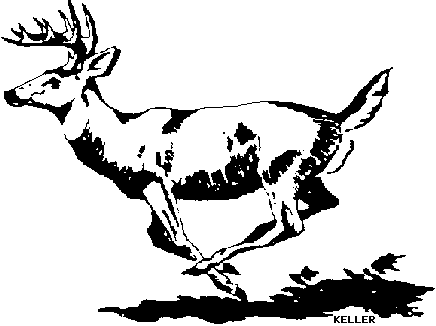
| Mortality | January 1995 | |
| Dan Martinez
| ||
I don't believe that the inability to do any preseason scouting hurt me in the least. The fact that I could not get out to hunt on opening day was probably a big factor in my lack of success, though. I had picked up the appropriate topo maps months in advance, and studied them intently. I did my homework and learned that the best elevation range for this species is between 4,000 and 6,000 feet. I identified a number of likely spots to camp around the Atascosa mountain range west of Lake Peņa Blanca. I left late on the morning of December 26th, and arrived in the early afternoon. As I arrived, I learned that the area is a rolling terrain of oak-grassland. After setting up camp, I went on a short excursion before darkness fell. Everywhere around me there were deer drops. The sun was low on the western horizon when I spotted my first pair of whitetail grazing on top of a high hill about half a mile away. They were silhouetted against the dusking sky. I just watched them graze, as I knew I could not reach them before darkness. I went back to camp, warmed up a can of chili, and crashed in my tent to the sound of rainfall all night long. When I awoke, the rain had stopped, but all the little draws between the rolling hills were flowing with some amount of water. My first foray of the day was to the north, to a bowl in the western shadow of Atascosa Peak, which, at 6,422 feet, is the highest point in this hunt unit. Last year's trip to unit 24A put me in similar elevations, but the thick, solid shield of vegetative cover there made travel very difficult. By contrast, here, except for the catclaw acacia, travel through the grass between the oak trees was easy. Only steep slopes at the higher elevations presented any difficulty to access. I soon spotted my second pair of whitetail, through the binos, in the middle of the bowl. I was halfway up the slope of a medium sized hill west of the bowl, looking toward Atascosa Peak. On this still overcast day, clouds obscured the tops of the north-south ridge of which Atascosa Peak was the tallest point, but it could be seen that the ridgetop had received a dusting of snow overnight. The two deer were a doe with her fawn. Over the next four days, this turned out to be a familiar sight. It turns out that in this area, the deer are more common than rabbits. In fact, their small size and their fluffy, snowy white tails reminded me of cottontails. I kept a running total of deer spotted during my four days of hunting: by the time I left on Friday afternoon, I had spotted 45 individuals! Yes, Forty-Five in four days! The trouble was, that of those 45, only one was a buck, and he was a spike of about 4 inches, seen at a distance of about a third of a mile. The rest were does and fawns. I tried chasing him up the mountain I spotted him on, but by the time I got to the top, he was long gone. Once, a doe and I spotted each other at about 75 yards across a narrow, but steep draw. I froze, and we just kept staring at each other for about two minutes. Tiring of this game, I slowly moved to my left, around a big boulder, until I was out of her sight. She did not spook when I moved. When I crawled over the top of the boulder to look at her again, she of course saw me, and we continued watching each other for another five minutes. She would occasionally put her head down and munch some grass, but she would soon look back up at me again and watch me as she chewed. Soon, I noticed her looking off to her right. It was a second doe climbing up her slope out of the draw to join her. This second doe grazed with her back to me the whole time, never knowing I was there. The first doe kept looking back and forth between doe #2 and me. Finally, they both grazed over the top of their hill until they were out of sight. If only one of them had horns! During all of this, I was able to swing my rifle over and take a look at each of them through the scope. I almost died on this trip. Seriously. I tried using the experts' advice to "wear out the seat of my pants, rather than the soles of my shoes," but that didn't work for me. On the second day, I set up high on the western slope of Atascosa Peak to be able to glass the maximum amount of terrain. I sat there from 10:30 AM until dark, and did not see a single deer. By contrast, the previous day, when I hiked my ass off, I had seen 17. So on day 3, I decided to go back to hiking my ass off. By the end of day 3, my deer spot count had reached 37, but I was wearing out. I had decided to hunt only one more day. On day four, I left early to still hunt the bottoms around camp. I ended up stopping to wait at a meadow sitting against a rock, hoping for a misfortunate buck to stumble in. As I sat, I watched the variable clouds drift in and out, and soon some rain started to reach the ground. I knew I wanted to get out that day sometime, but I still had camp to pack up, and I didn't want to attack muddy roads in my 2WD truck. It was about 9:30 AM when I headed back to camp to pack it up. The rain had stopped, allowing me to get camp packed up by 11:00 in total dryness. With the truck all packed up, I could go out on one last foray, and just hop in the truck when done. While studying my topo the night before, I noticed a medium long, medium wide canyon going east up the slope of the big ridge. The topo showed a bare grass south facing slope at the north of the canyon, and a tree covered north facing slope on the south of the canyon. Experience on previous days led me to create a strategy of hiking into east-west canyons halfway up the bare south facing slope. This allowed me to be able to look into the trees on the opposite north facing slope. There was no way I could hide from any deer bedded among the trees, and they would frequently bust out of cover. I hoped for a cross-canyon shot at a busting buck. Near the mouth of the canyon, as I entered, I did bust out another doe and fawn. As I continued deeper into the canyon, the walls got steeper and closer together, but no more deer busted. When I got to the end of the canyon, it opened up again into a spectacularly steep bowl with vertical bare rock ramparts along the top edge. But there were no deer. If there were, they would have had a tough time escaping within the shear walls of the box canyon. I cursed the oversized rabbits for outsmarting me again, as I knew my hunt had drawn to an unsuccessful end. I started to climb up out of the canyon, trying to reach the the top of the ridge on whose slope I had walked in on. I reached a rock face which reposed at about a 45 degree angle. The face had hand and foot holds which afforded adequate purchase. A rock about the size of the front end of my Ranger pickup from the windshield-forward confronted me as I had climbed about 2/3 of the way up the exposed rock face. As I placed my hand on the rock, I noticed an unusual sound and stopped to look around. Seeing nothing unusual, I continued to crawl on top of the rock to get over it. As I started to unweight my trailing leg when I was almost totally on top of the rock, THE ROCK MOVED! In the moment of sheer terror that next ensued, I considered my situation: I was on top of a very large rock, which in turn was on top of an exposed rock face which reposed at a 45 degree angle, high up on a canyon wall at least 300 feet above the canyon bottom. One hand clutched a rifle, while the other clutched a handhold on the now obviously unstable rock. I was hunting alone, and all that my wife knew was that I was hunting somewhere "south of Tucson." I have two young boys at home. If the rock let go, it would at some point roll right over the top of me as it took me to the bottom of the canyon. I wouldn't have a chance. I'm writing this story. I did not die. I jumped (as gingerly as I could in a panic situation) down off the rock, momentarily still in the downward path of the rock. Then, just as quickly, to the right, out of the direct path. I watched the rock for a moment, fully expecting to witness the awesome power of its roll to the bottom. The rock never did let go. As I scrambled up to the ridgetop, I found that I had lost all appetite for the hunt. My foremost thought was getting back to my truck and level ground. As I descended from the mountain (seeing several more does and fawns on the way), the incident moved me to reflect on what the lives of those around me might be like if I were to suddenly depart. You guys would probably soon get over it, but what of my young family? I don't know; life is full of risks. One can certainly choose to retreat from all risky endeavors, and perhaps live long and prosper. But is that really a life? Myself, I've always chosen to engage in somewhat dangerous activities. If you never get in a position where you fear for your life, how can you ever understand and appreciate its true worth?
© Honeywell Sportsman Club. All rights reserved. | ||
| If you enjoyed this story, or found it useful, please consider clicking here to join the NRA at a discount of $15 off the normal membership cost. You will be supporting both this website and adding your voice in support of the Second Amendment. Thank you very much. |

|

|
|










